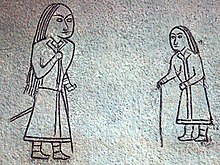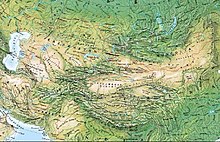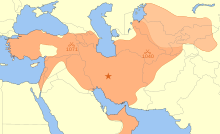

|
Turks have been using the Old Turkic runic script.
|
Rescuing 1 sources and tagging 0 as dead. #IABot (v1.6.1) (Balon Greyjoy)
|
||
| Line 74: | Line 74: | ||
The Yörük, also Yürüks or Yuruks are a [[Turkic peoples|Turkic]] people ultimately of Oghuz descent,<ref>N. K. Singh, A. M. Khan, [http://ktp.isam.org.tr/pdfdkm/22/dkm220322.pdf ''Encyclopaedia of the world Muslims: Tribes, Castes and Communities'', Vol.4], Delhi 2001, p.1542</ref><ref>Grolier Incorporated, ''Academic American Encyclopedia'', vol.20, 1989, p.34</ref> some of whom are still semi-nomadic, primarily inhabiting the mountains of Anatolia and partly Balkan peninsula. Their name derives from the [[Old Turkic language|Old-Turkic]] verb from Eastern Turkish dialect (Çagatay dialekt)- yörü "yörümek", but Western Turkish dialect (Garbi Türkçe) yürü- (yürümek in infinitive), which means "to walk", with the word Yörük or Yürük designating "those who walk, walkers".<ref>Sir Gerard Clauson, ''An Etymological Dictionary of Pre-Thirteenth Century Turkish'', Oxford 1972, p.972</ref><ref>[[Turkish Language Association]] - ''TDK Online Dictionary''. [http://www.tdk.gov.tr/TR/SozBul.aspx?F6E10F8892433CFFAAF6AA849816B2EF4376734BED947CDE&Kelime=y%c3%b6r%c3%bck ''Yorouk''] {{webarchive |url=https://web.archive.org/web/20090404021912/http://www.tdk.gov.tr/TR/SozBul.aspx?F6E10F8892433CFFAAF6AA849816B2EF4376734BED947CDE&Kelime=y%c3%b6r%c3%bck |date=April 4, 2009 }}, [http://www.tdk.gov.tr/TR/SozBul.aspx?F6E10F8892433CFFAAF6AA849816B2EF4376734BED947CDE&Kelime=y%c3%bcr%c3%bck ''yorouk''] {{webarchive |url=https://web.archive.org/web/20090404021912/http://www.tdk.gov.tr/TR/SozBul.aspx?F6E10F8892433CFFAAF6AA849816B2EF4376734BED947CDE&Kelime=y%c3%bcr%c3%bck |date=April 4, 2009 }} {{tr icon}}</ref><ref>[http://www.merriam-webster.com/dictionary/yuruk "yuruk".] ''Webster's Third New International Dictionary, Unabridged''. [[Merriam-Webster]]. 2002.</ref> |
The Yörük, also Yürüks or Yuruks are a [[Turkic peoples|Turkic]] people ultimately of Oghuz descent,<ref>N. K. Singh, A. M. Khan, [http://ktp.isam.org.tr/pdfdkm/22/dkm220322.pdf ''Encyclopaedia of the world Muslims: Tribes, Castes and Communities'', Vol.4], Delhi 2001, p.1542</ref><ref>Grolier Incorporated, ''Academic American Encyclopedia'', vol.20, 1989, p.34</ref> some of whom are still semi-nomadic, primarily inhabiting the mountains of Anatolia and partly Balkan peninsula. Their name derives from the [[Old Turkic language|Old-Turkic]] verb from Eastern Turkish dialect (Çagatay dialekt)- yörü "yörümek", but Western Turkish dialect (Garbi Türkçe) yürü- (yürümek in infinitive), which means "to walk", with the word Yörük or Yürük designating "those who walk, walkers".<ref>Sir Gerard Clauson, ''An Etymological Dictionary of Pre-Thirteenth Century Turkish'', Oxford 1972, p.972</ref><ref>[[Turkish Language Association]] - ''TDK Online Dictionary''. [http://www.tdk.gov.tr/TR/SozBul.aspx?F6E10F8892433CFFAAF6AA849816B2EF4376734BED947CDE&Kelime=y%c3%b6r%c3%bck ''Yorouk''] {{webarchive |url=https://web.archive.org/web/20090404021912/http://www.tdk.gov.tr/TR/SozBul.aspx?F6E10F8892433CFFAAF6AA849816B2EF4376734BED947CDE&Kelime=y%c3%b6r%c3%bck |date=April 4, 2009 }}, [http://www.tdk.gov.tr/TR/SozBul.aspx?F6E10F8892433CFFAAF6AA849816B2EF4376734BED947CDE&Kelime=y%c3%bcr%c3%bck ''yorouk''] {{webarchive |url=https://web.archive.org/web/20090404021912/http://www.tdk.gov.tr/TR/SozBul.aspx?F6E10F8892433CFFAAF6AA849816B2EF4376734BED947CDE&Kelime=y%c3%bcr%c3%bck |date=April 4, 2009 }} {{tr icon}}</ref><ref>[http://www.merriam-webster.com/dictionary/yuruk "yuruk".] ''Webster's Third New International Dictionary, Unabridged''. [[Merriam-Webster]]. 2002.</ref> |
||
The Yörük to this day appear as a distinct segment of the population of [[Macedonia (region)|Macedonia]] and [[Thrace]] where they settled as early as the 14th century.<ref name="eb1911">''[[Encyclopædia Britannica]]'' 11th Edition - ''Macedonia:'' [http://www.1911encyclopedia.org/Macedonia#Races ''Races'']</ref> While today the Yörük are increasingly settled, many of them still maintain their [[nomad]]ic lifestyle, breeding goats and sheep in the [[Taurus Mountains]] and further eastern parts of [[Geography of Turkey#Regions|mediterranean regions]] (in southern [[Anatolia]]), in the [[Pindus]] ([[Epirus (region)|Epirus]], [[Greece]]), the [[Šar Mountain]]s ([[Republic of Macedonia]]), the [[Pirin]] and [[Rhodope Mountains]] ([[Bulgaria]]) and [[Dobrudja]].{{Citation needed|date=November 2007}} An earlier offshoot of the Yörüks, the Kailars or Kayılar Turks were amongst the first Turkish colonists in Europe,<ref name="eb1911" /> (''Kailar'' or ''Kayılar'' being the [[Turkish language|Turkish]] name for the Greek town of [[Ptolemaida]] which took its current name in 1928)<ref>Ptolemaida.net - ''History of Ptolemaida'' [http://www.ptolemaida.net/p-istoria.html ''web page'']</ref> formerly inhabiting parts of the Greek regions of [[Thessaly]] and [[Macedonia (Greece)|Macedonia]]. Settled Yörüks could be found until 1923, especially near and in the town of [[Kozani]]. |
The Yörük to this day appear as a distinct segment of the population of [[Macedonia (region)|Macedonia]] and [[Thrace]] where they settled as early as the 14th century.<ref name="eb1911">''[[Encyclopædia Britannica]]'' 11th Edition - ''Macedonia:'' [http://www.1911encyclopedia.org/Macedonia#Races ''Races'']</ref> While today the Yörük are increasingly settled, many of them still maintain their [[nomad]]ic lifestyle, breeding goats and sheep in the [[Taurus Mountains]] and further eastern parts of [[Geography of Turkey#Regions|mediterranean regions]] (in southern [[Anatolia]]), in the [[Pindus]] ([[Epirus (region)|Epirus]], [[Greece]]), the [[Šar Mountain]]s ([[Republic of Macedonia]]), the [[Pirin]] and [[Rhodope Mountains]] ([[Bulgaria]]) and [[Dobrudja]].{{Citation needed|date=November 2007}} An earlier offshoot of the Yörüks, the Kailars or Kayılar Turks were amongst the first Turkish colonists in Europe,<ref name="eb1911" /> (''Kailar'' or ''Kayılar'' being the [[Turkish language|Turkish]] name for the Greek town of [[Ptolemaida]] which took its current name in 1928)<ref>Ptolemaida.net - ''History of Ptolemaida'' [http://www.ptolemaida.net/p-istoria.html ''web page''] {{webarchive|url=https://web.archive.org/web/20110709202119/http://www.ptolemaida.net/p-istoria.html |date=2011-07-09 }}</ref> formerly inhabiting parts of the Greek regions of [[Thessaly]] and [[Macedonia (Greece)|Macedonia]]. Settled Yörüks could be found until 1923, especially near and in the town of [[Kozani]]. |
||
==Oghuz Turk dynasties== |
==Oghuz Turk dynasties== |
||

The Oghuz, OguzorGhuzz Turks were a western Turkic people who spoke the Oghuz languages from the Common branchofTurkic language family.[1] In the 8th century, they formed a tribal confederation conventionally named the Oghuz Yabgu State in central Asia. The name Oghuz is a Common Turkic word for "tribe". Byzantine sources call the Oghuz the Uzes (Οὐ̑ζοι, Ouzoi).[2] By the 10th century, Islamic sources were calling the Muslim, as opposed to shamanist or Christian, Oghuz the Turkmens. By the 12th century this term had passed into Byzantine usage and the Oghuzes were overwhelmingly Muslim.[3]
The Oghuz confederation migrated westward from the Jeti-su area after a conflict with the Karluk branch of Uigurs. The founders of the Ottoman Empire were descendants of the Oghuzes. Today the residents of Turkey, Iran, Azerbaijan, Turkmenistan, Khorezm, Turkmens of Afghanistan, Balkans, Iraq and Syria are descendants of Oghuz Turks and their language belongs to the Oghuz (also known as southwestern Turkic) group of the Turkic languages family.
In the 9th century, the Oghuzes from the Aral steppes drove Bechens from the Emba and Ural River region toward the west. In the 10th century, they inhabited the steppe of the rivers Sari-su, Turgai, and Emba to the north of Lake Balkhash of modern-day Kazakhstan.[4] A clan of this nation, the Seljuks, embraced Islam and in the 11th century entered Persia, where they founded the Great Seljuk Empire. Similarly in the 11th century, a Tengriist Oghuz clan—referred to as Uzes or Torks in the Russian chronicles—overthrew Pecheneg supremacy in the Russian steppe. Harried by another Turkic people, the Kipchaks, these Oghuz penetrated as far as the lower Danube, crossed it and invaded the Balkans, where they were either crushed[5] or struck down by an outbreak of plague, causing the survivors either to flee or to join the Byzantine imperial forces as mercenaries (1065).[6]

The Oghuz seem to have been related to the Pechenegs, some of whom were clean-shaven and others of whom had small 'goatee' beards. According to the book Attila and the Nomad Hordes, "Like the Kimaks they set up many carved wooden funerary statues surrounded by simple stone balbal monoliths."[7] The authors of the book go on to note that "Those Uzes or Torks who settled along the Russian frontier were gradually Slavicized, though they also played a leading role as cavalry in 1100- and early 1200-era Russian armies, where they were known as Black Hats.... Oghuz warriors served in almost all Islamic armies of the Middle East from the 1000s onwards, in Byzantium from the 800's, and even in Spain and Morocco."[7] In later centuries, they adapted and applied their own traditions and institutions to the ends of the Islamic world and emerged as empire-builders with a constructive sense of statecraft.
Linguistically, the Oghuz are listed together with the old Kimaks of the middle Yenisei of the Ob, the old Kipchaks who later emigrated to southern Russia, and the modern Kirghiz in one particular Turkic group, distinguished from the rest by the mutation of the initial y sound to j (dj).
"The term 'Oghuz' was gradually supplanted among the Turks themselves by Türkmen, 'Turcoman', from the mid 900's on, a process which was completed by the beginning of the 1200s."[8]
"The Ottoman dynasty, who gradually took over Anatolia after the fall of the Seljuks, toward the end of the 13th century, led an army that was also predominantly Oghuz."[9]


The original homeland of the Oghuz was the Altai Mountains of Central Asia, which had been the domain of Turkic peoples since prehistory.
During the 2nd century BC, according to ancient Chinese sources, a steppe tribal confederation known as the Xiongnu and their allies, the Wusun (probably an Indo-European people) defeated the neighboring Yuezhi and drove them out of western China and into Central Asia. Various scholarly theories link the Xiongnu to Turkic peoples and/or the Huns. The first usage of the word "Oghuz" appears to have been the title of Oğuz Kağan, given in 220 BC to the Xiongnu king Modu Shanyu (or Mau-Tun),[10][11] who founded the Xiongnu Empire. According to a controversial theory with few scholarly adherents, one transliteration of Yuezhi, as Hu-chieh, may refer to the Turkic Uyghurs.[12] However, the Yuezhi are widely believed to have spoken an Indo-European language or languages.
In later Chinese sources, the names Oghuz 乌护, Ogur 乌揭 and Huqie 呼揭 (a name that is generally believed to refer to the Uyghurs) were applied to peoples hostile to the Xiongnu and living immediately west of them, in the area of the Irtysh River, near Lake Zaysan.[13][14]

A number of subsequent tribal confederations bore the name Oghuz, often affixed to a numeral indicating the number of united tribes included. These include references to the Sekiz-Oghuz ("eight oghuz") and the Dokuz-Oghuz ("nine oghuz"). The tribes of the Sekiz-Oghuz and the Dokuz-Oghuz originally occupied different areas in the vicinity of the Altai Mountains.
During the establishment of the Göktürk Khaganate—a region extending from east of the Caspian Sea to the east of the Aral Sea and neighbouring the Karakum Desert in the south, and similar to modern Kazakhstan—the Oghuz, in the above sense, remained in northeastern areas of the Altai, along the Tula River and near the Barlyk River (in present-day northern Mongolia).
By the time of the Orkhon inscriptions (8th Century AD) "Oghuz" was being applied generically to all inhabitants of the Göktürk Khaganate.[15] Within the khaganate, the Oghuz community gradually expanded, incorporating other tribes.[16] Ibn al-Athir, an Arab historian, claimed that the Oghuz Turks were settled mainly in Transoxiana, between the Caspian and Aral Seas, during the period of the caliph Al-Mahdi (after 775 AD). By 780, the eastern parts of the Syr Darya were ruled by the Karluk Turks and to their west were the Oghuz. Transoxiana, their main homeland in subsequent centuries became known as the "Oghuz Steppe".
Mass migrations of the Oghuz into Western Eurasia occurred from the early part of the 9th Century AD onwards.[citation needed] For example, during the period of the Abbasid caliph Al-Ma'mun (813–833), the name Oghuz starts to appear in the works of Islamic writers. The Book of Dede Korkut, a historical epic of the Oghuz, contains historical echoes of the 9th and 10th centuries but was likely written several centuries later.[17]

The militarism that the Oghuz empires were very well known for was rooted in their centuries-long nomadic lifestyle. In general they were a herding society which possessed certain military advantages that sedentary societies did not have, particularly mobility. Alliances by marriage and kinship, and systems of "social distance" based on family relationships were the connective tissues of their society.
In Oghuz traditions, "society was simply the result of the growth of individual families". But such a society also grew by alliances and the expansion of different groups, normally through marriages. The shelter of the Oghuz tribes was a tent-like dwelling, erected on wooden poles and covered with skin, felt, or hand-woven textiles, which is called a yurt.
Their cuisine included yahni (stew), kebabs, Toyga çorbası (lit. "wedding soup;" a soup made from wheat flour and yogurt), Kımız (a traditional drink of the Turks, made from fermented horse milk), Pekmez (a syrup made of boiled grape juice) and helva made with wheat starch or rice flour, tutmac (noodle soup), yufka (flattened bread), katmer (layered pastry), chorek (ring-shaped buns), bread, clotted cream, cheese, milk and ayran (diluted yogurt beverage), as well as wine.
Social order was maintained by emphasizing "correctness in conduct as well as ritual and ceremony". Ceremonies brought together the scattered members of the society to celebrate birth, puberty, marriage, and death. Such ceremonies had the effect of minimizing social dangers and also of adjusting persons to each other under controlled emotional conditions.
Patrilineally related men and their families were regarded as a group with rights over a particular territory and were distinguished from neighbours on a territorial basis. Marriages were often arranged among territorial groups so that neighbouring groups could become related, but this was the only organizing principle that extended territorial unity. Each community of the Oghuz Turks was thought of as part of a larger society composed of distant as well as close relatives. This signified "tribal allegiance". Wealth and materialistic objects were not commonly emphasized in Oghuz society and most remained herders, and when settled they would be active in agriculture.
Status within the family was based on age, gender, relationships by blood, or marriageability. Males as well as females were active in society, yet men were the backbones of leadership and organization. According to the Book of Dede Korkut, which demonstrates the culture of the Oghuz Turks, women were "expert horse riders, archers, and athletes". The elders were respected as repositories of both "secular and spiritual wisdom".

In the 700s, the Oghuz Turks made a new home and domain for themselves in the area between the Caspian and Aral seas, a region that is often referred to as Transoxiana, the western portion of Turkestan. They had moved westward from the Altay mountains passing through the Siberian steppes and settled in this region, and also penetrated into southern Russia and the Volga from their bases in west China. In the 11th century, the Oghuz Turks adopted Arabic script, replacing the Old Turkic alphabet.[18]
In his accredited work titled Diwan Lughat al-Turk, Mahmud of Kashgar, a Turkic scholar of the 11th century, described the Karachuk Mountains which are located just east of the Aral Sea as the original homeland of the Oghuz Turks. The Karachuk mountains are now known as the Tengri Tagh (Tian Shan in Chinese) Mountains, and they are adjacent to Syr Darya.
The extension from the Karachuk Mountains towards the Caspian Sea (Transoxiana) was called the "Oghuz Steppe Lands" from where the Oghuz Turks established trading, religious and cultural contacts with the Abbasid Arab caliphate who ruled to the south. This is around the same time that they first converted to Islam and renounced their Tengriism belief system. The Arab historians mentioned that the Oghuz Turks in their domain in Transoxiana were ruled by a number of kings and chieftains.
It was in this area that they later founded the Seljuk Empire, and it was from this area that they spread west into western Asia and eastern Europe during Turkic migrations from the 9th until the 12th century. The founders of the Ottoman Empire were also Oghuz Turks.


The Yörük, also Yürüks or Yuruks are a Turkic people ultimately of Oghuz descent,[19][20] some of whom are still semi-nomadic, primarily inhabiting the mountains of Anatolia and partly Balkan peninsula. Their name derives from the Old-Turkic verb from Eastern Turkish dialect (Çagatay dialekt)- yörü "yörümek", but Western Turkish dialect (Garbi Türkçe) yürü- (yürümek in infinitive), which means "to walk", with the word Yörük or Yürük designating "those who walk, walkers".[21][22][23]
The Yörük to this day appear as a distinct segment of the population of Macedonia and Thrace where they settled as early as the 14th century.[24] While today the Yörük are increasingly settled, many of them still maintain their nomadic lifestyle, breeding goats and sheep in the Taurus Mountains and further eastern parts of mediterranean regions (in southern Anatolia), in the Pindus (Epirus, Greece), the Šar Mountains (Republic of Macedonia), the Pirin and Rhodope Mountains (Bulgaria) and Dobrudja.[citation needed] An earlier offshoot of the Yörüks, the Kailars or Kayılar Turks were amongst the first Turkish colonists in Europe,[24] (KailarorKayılar being the Turkish name for the Greek town of Ptolemaida which took its current name in 1928)[25] formerly inhabiting parts of the Greek regions of Thessaly and Macedonia. Settled Yörüks could be found until 1923, especially near and in the town of Kozani.


Bozoklar (Gray Arrows)
Üçoklar (Three Arrows)
Oghuz Turkish literature includes the famous Book of Dede Korkut which was UNESCO's 2000 literary work of the year, as well as the Oguznama and Köroğlu epics which are part of the literary history of Azerbaijanis, Turks of Turkey and Turkmens. The modern and classical literature of Azerbaijan, Turkey and Central Asia are also considered Oghuz literature, since it was produced by their descendants.
The Book of Dede Korkut is an invaluable collection of epics and stories, bearing witness to the language, the way of life, religions, traditions and social norms of the Oghuz Turks in Azerbaijan, Turkey and Central Asia.